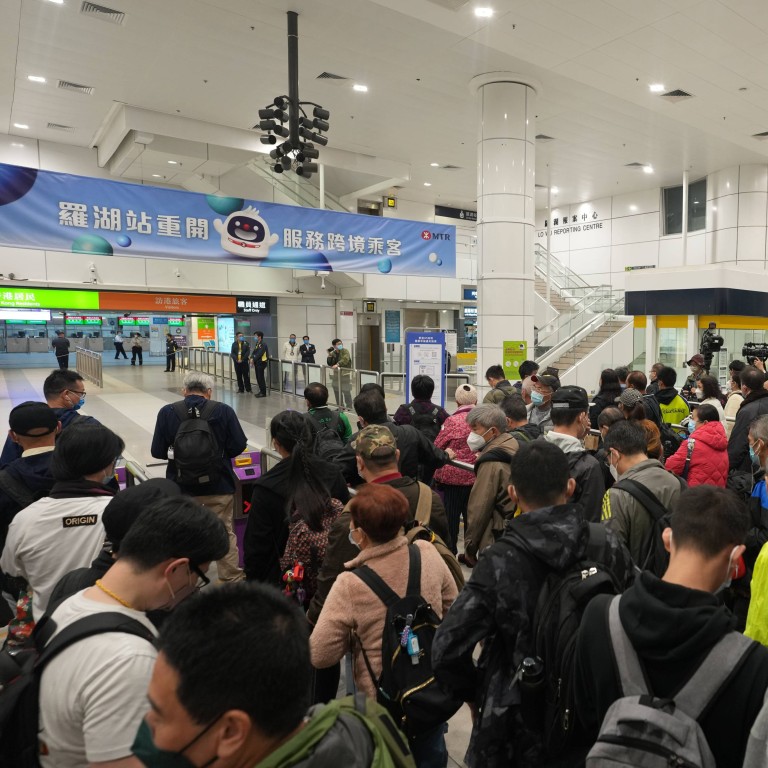
Border crossings: a look at the first day of travel as all checkpoints between Hong Kong and mainland China reopen, free from Covid restrictions
- City braces for an influx of visitors from up north as travel free of quarantine, quotas and Covid-19 tests resumes
- But analysts say a major bounce back for the economy may not come overnight, although business sentiment has brightened
Hong Kong welcomed an influx of visitors from across the border with mainland China on Monday as all checkpoints finally reopened, marking the full resumption of quarantine-free travel, without quotas and Covid-19 tests on either side.
Three land crossings closed to passengers for as long as three years reopened on Monday – Lo Wu, Lok Ma Chau and Heung Yuen Wai.
Lo Wu and Lok Ma Chau suspended passenger crossings since early 2020 and only a cargo clearance service was available at the Heung Yuen Wai control point after it started operations in August 2020.
When will Hong Kong tourism rebound? New travel habits may delay process, minister says
The only people who still need negative results from polymerase chain reaction (PCR) tests for the coronavirus are those who have spent time outside Hong Kong, the mainland or Macau in the seven days before they plan to cross the border.
Analysts have said that a full economic rebound may not come overnight after the reopening of the border, but business sentiment has turned more optimistic as normality resumes.
‘Lessons learned’: John Lee on Hong Kong Covid policy ahead of full border reopening
A case of déjà vu is expected at the Lo Wu control point, once the busiest checkpoint of the city, when it reopens its doors at 6.30am.
Reporting by Kahon Chan, Jess Ma, Emily Hung, Harvey Kong, Elizabeth Cheung, Oscar Liu and Ng Kang-chung
Here are updates live from the border:
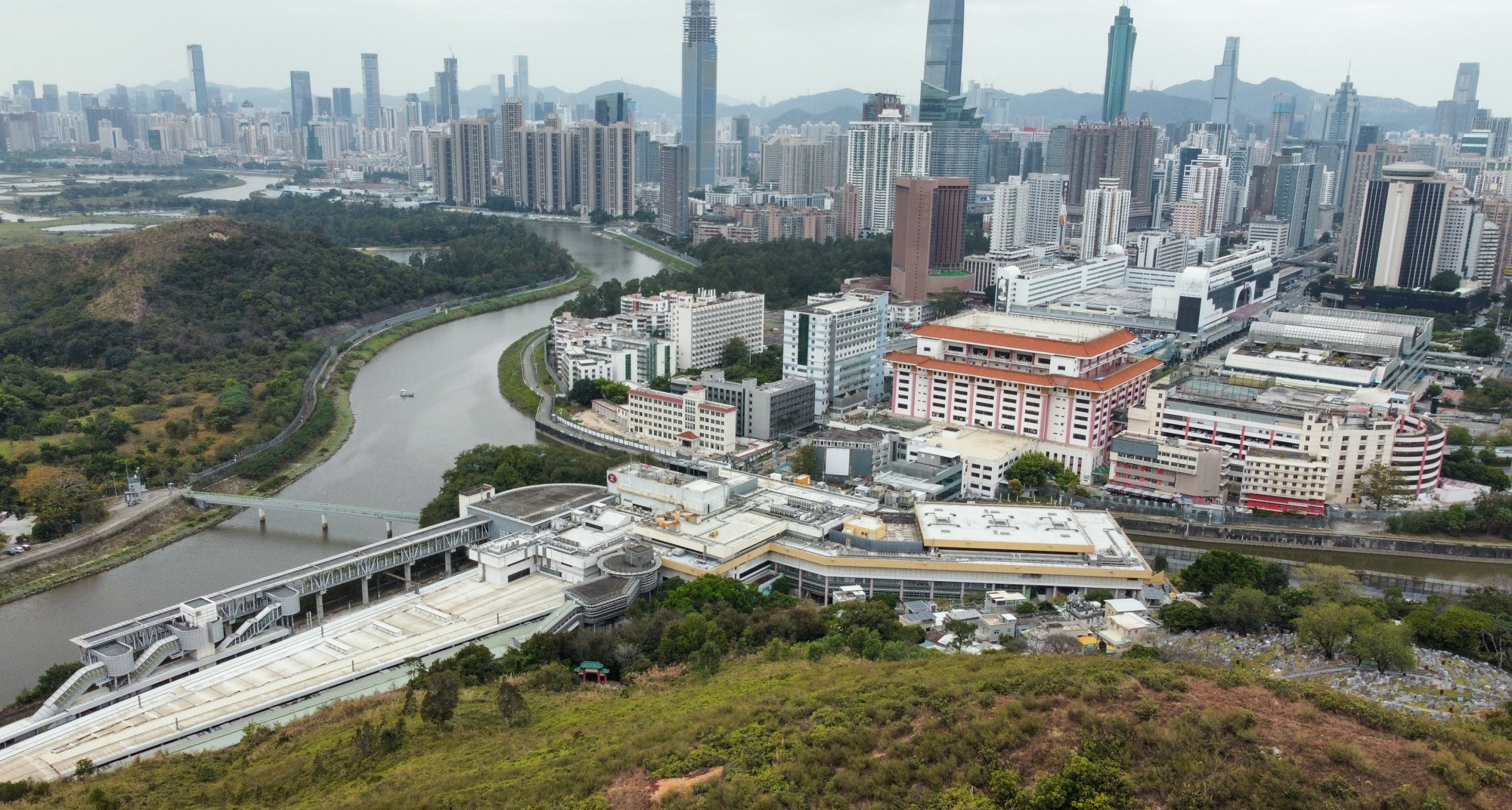
Hong Kong tourists hail Heung Yuen Wai crossing
Some Hong Kong residents holidaying on the mainland were drawn to the Heung Yuen Wai checkpoint because of great deals and cheaper rides.
Judy Lui, a 51-year-old retiree, has signed up for a two-day trip to Huidong with friends. Her itinerary features hot springs, two buffets and a seaside hotel stay costing only HK$399 (US$50.84).
As she shared her excitement about snagging a great deal, she also praised the new Heung Yuen Wai facility while waiting for other tour group members.
“We came here earlier as we’re worried about emergencies and crowds. It turned out to be such a smooth ride – convenient, fast and organised. And beautiful!”
Angel So, coordinator for tour organiser Big Line Holiday, said nearly 100 Hongkongers had signed up even though the deal was only advertised two days ago.
Another retiree Ricky Tsang, 73, was travelling with two other friends. The former civil servant said while the checkpoint’s location was convenient, it was most important that it only took him HK$4 on two rides to reach it from his Sha Tin home, thanks to the elderly bus fare discount.

Most travellers Hongkongers
As of Monday noon, a total of 83,000 people had crossed the border through land checkpoints between Hong Kong and the mainland, according to Secretary for Security Chris Tang Ping-keung. Around 80 per cent of travellers were Hongkongers, he said.
More people were heading to the north, with 50,000 of them travelling from the city to the mainland. The remaining 33,000 were those heading in the opposite direction.
Tang said he had visited the Heung Yuen Wai-Liantian border crossing, as well as the Lok Ma Chau-Huanggang and Lo Wu control points on Monday to understand the latest situation.
“All border points operated normally and smoothly,” he told the media in Lo Wu.
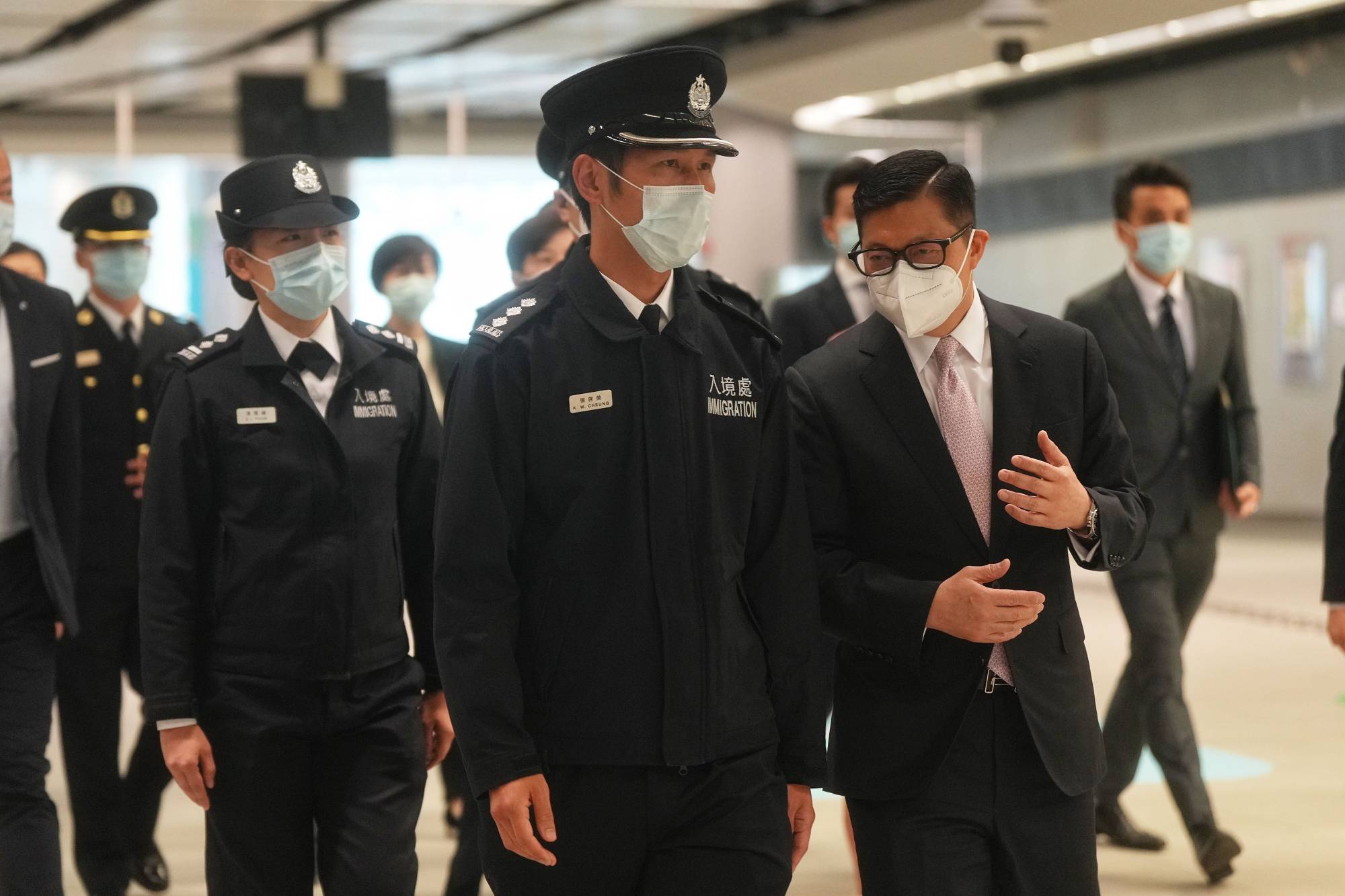
Regarding reports from some travellers on difficulties in making health declarations when entering the mainland, Tang said care teams had been mobilised to help the elderly or others unfamiliar with the requirement.
“We are working with the other parties on the mainland side to see how we can make it more effective and user-friendly for passengers,” Tang said.
He added that the government had not identified any resurgence in parallel trading activities since the first phase of border reopening launched early last month. Authorities will continue to monitor the situation.
Heavier traffic at Lo Wu in the afternoon
The volume of border crossings got heavier in the afternoon at the Lo Wu control point, with many travellers seen at the square outside the immigration building on the Shenzhen side.
Travellers coming out of the building were often greeted by many illegal taxi drivers looking for businesses.
The Luohu Commercial City mall has been lit up, with more than half of the shops opened. But there are still barely any shoppers.
Meanwhile, long queues were forming at the immigration complex on the Hong Kong side, as travellers needed to have their health declarations scanned by officers one at a time. Many were rejected due to inaccurate information, and had to refill the form.
Quiet border mall
Shops remain shuttered in a Liantang mall at the border checkpoint in Shenzhen.
Ring Wu, shopkeeper of a lifestyle outlet at the arcade, said the mall began to recruit tenants three years ago but about 70 per cent of them had abandoned their rental spaces before the Liantang checkpoint finally opened.
“This location is special because there are few residences nearby. Without the control point, this place has no commercial value,” Wu said. “They couldn’t wait any longer.”
He still expressed faith in the mall’s outlook and has held on to his lease for the past 18 months, as he expected to see more travellers when the new checkpoint gained traction in future.
Travellers arriving at the Liantang checkpoint would have to go through the mall to reach the train station outside.
Smooth operations at Lo Wu station
The MTR Corporation said a total of 22,000 passengers had crossed the border via Lo Wu station as of Monday morning, adding that the overall operation was smooth.
It also reminded passengers to fill up pre-departure health declarations requested by mainland authorities.
Inspections by officials at border crossings
Senior officials inspected various border checkpoints in the morning. Secretary for Security Chris Tang Ping-keung attended a launch ceremony of clearance operations for passengers at the Heung Yuen Wai control point, describing the new service as “people-oriented”.
A few officials, including Chief Secretary Eric Chan Kwok-ki and education minister Christine Choi Yuk-lin, also visited the Lo Wu checkpoint to observe operations.
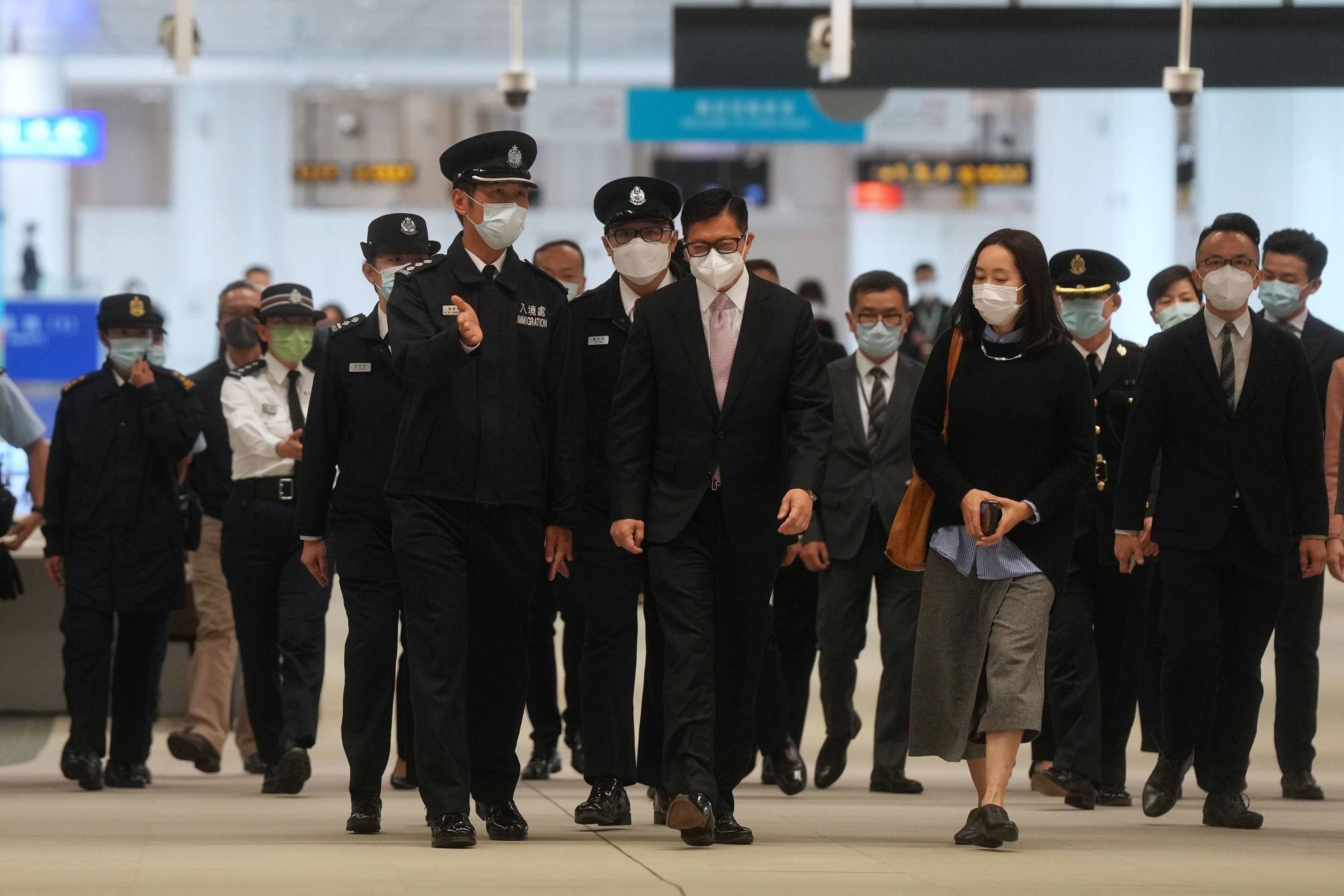
Shopkeepers near border geared for reopening
Zhang Fei, 34, the owner of a tailor shop in Luohu Commercial City on the Shenzhen side, was among the few businesses opened.
He said he had maintained operations throughout the pandemic by leaning on a pool of local customers from social media promotions.
“I am quite hopeful, as the border reopens, more people will visit the mall and see us,” he said. “But it should take some time to return to pre-Covid levels.”
He added that some two-thirds of shopkeepers had come back over the past few days to do cleaning, ahead of the reopening of the Lo Wu control point. He has also renovated his shop.
Wang Feihong, 40, was thrilled to learn of the reopening of the Lo Wu control point and has returned to his shop to test his toy drones.
“I came back two days ago to clean and restock my goods,” he said, “More than half of my customers were Hongkongers, and the rest were locals or overseas visitors.”
Wang said that when the shop was closed, he worked as a delivery man to provide for his children.
“I was paying 26,000 yuan for rent every month, luckily the landlords waived the rent, otherwise I can hardly keep my business.”
Meanwhile, the building next to the control point, formerly another hotspot for last-minute shopping, has been closed for renovations. The complex will be turned into a temporary clearance point.
Pharmacy sector: hope for a 20 per cent sales increase
Hong Kong General Chamber of Pharmacy vice-chairman Cheung Tak-wing said its members observed normal business operations in the morning without a noticeable increase in mainland customers. He expected sales would surge about 20 per cent compared with when the border partially reopened on January 8.
“Hopefully there will be more people coming in the afternoon and on Tuesday, then we can have a better picture of how to handle customer flow and demand,” Cheung said, adding pharmacies had been prepared since January.
“Most of them have replenished stock before some control points reopened on January 8, but the sales were not as ideal as expected, so most pharmacies are observing the situation before stocking up again as they still have inventories,” Cheung noted.
Ghost mall
The Luohu Commercial City mall on the Shenzhen side next to the control point, once flooded by cross-border travellers in pre-Covid times, was almost empty, with only a handful of retailers opened.
But the shopkeepers were at ease, as landlords have waived their rent in the past three years. Tenants only had to pay management fees at a 50 per cent discount, which is around 1,000 yuan (HK$1,158).
Kelvin Wu, 34, the owner of a shop selling watches and leather goods, is optimistic about business and returned to the shop early in the morning to do some cleaning.
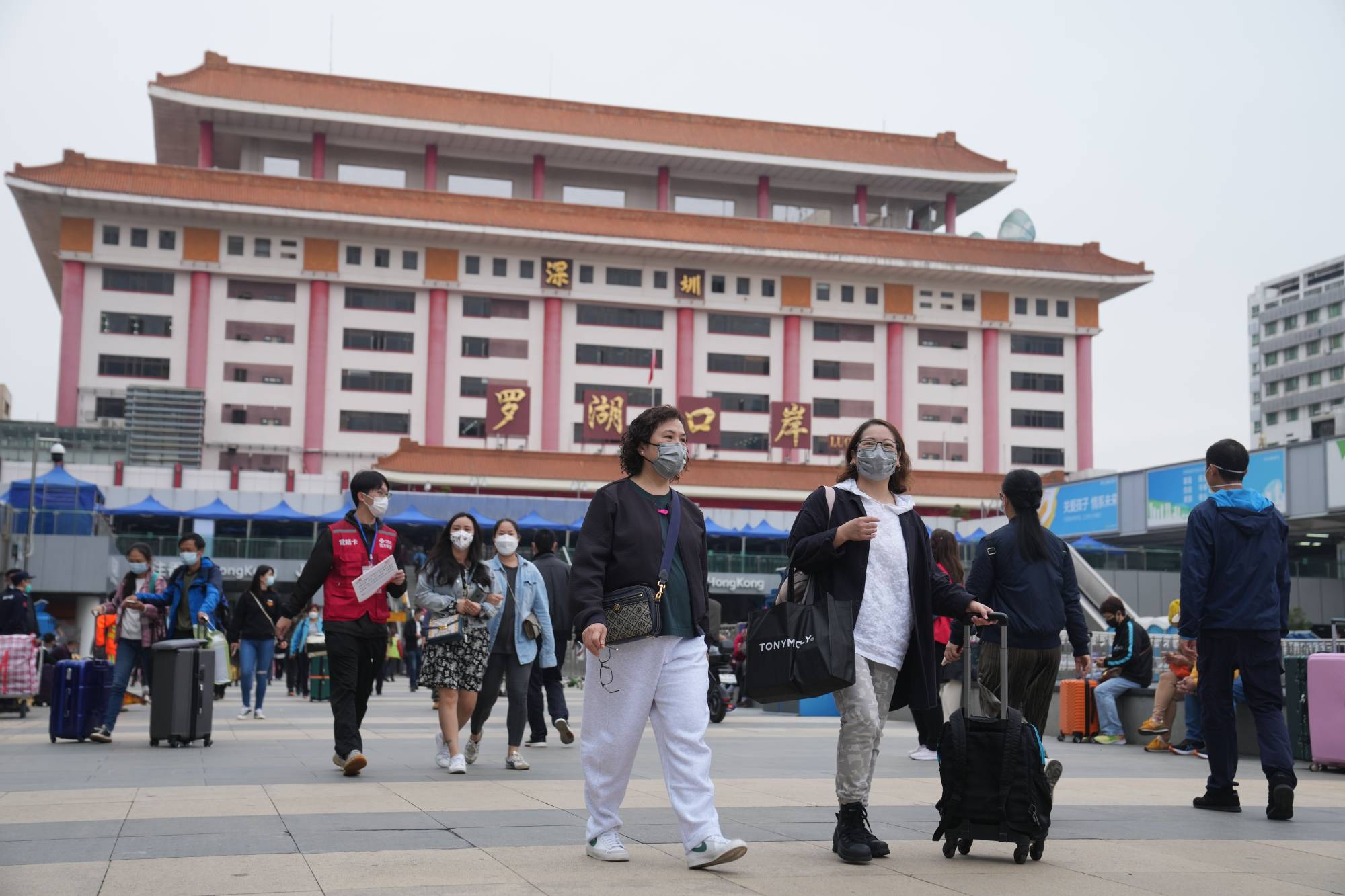
“I visited the border this morning, there were quite a lot of people,” he said. “During the pandemic, we did not open and started selling our goods online, some orders were from Hong Kong too.”
Wu said he was worried his business might not be able to survive if the landlord started charging rent again.
“If our business can return to at least 50 per cent of pre-pandemic levels, we can still handle it, but we are not sure if that will happen,” he added, revealing he made a profit of about HK$30,000 monthly in pre-Covid times.
Futian centre the only self-service point for Hong Kong visas
The queue for self-serviced Hong Kong entry visa renewal continued to grow as officials at the Futian administration services centre warned of a two-hour wait.
A Post reporter approached an officer at the centre and was told the venue was the only location in Shenzhen for such services. Applicants were advised to come again in the evening as the service is available round the clock.
Mainlanders were seen asking officials for clarifications, as some were confused as to whether they needed a reservation to use the kiosks or whether over-the-counter services were still available.
Evans Luo, 27, told a Post reporter that he had known since last week that self-serviced visa renewals would be available.
“I thought there would be no one here once the machines became available, but I discovered that it seems like no one has to go to work today,” Luo lamented.
The software developer said he had been unsuccessful in reserving a slot to renew his visa over the past weeks. He hoped to get his visa ready for ad hoc trips to the city to shop for electronics and skincare products.
Several others in the queue, who wished to remain anonymous, told the Post they had no concrete travel plans to the city yet, but hoped to get their visas primed for travel.
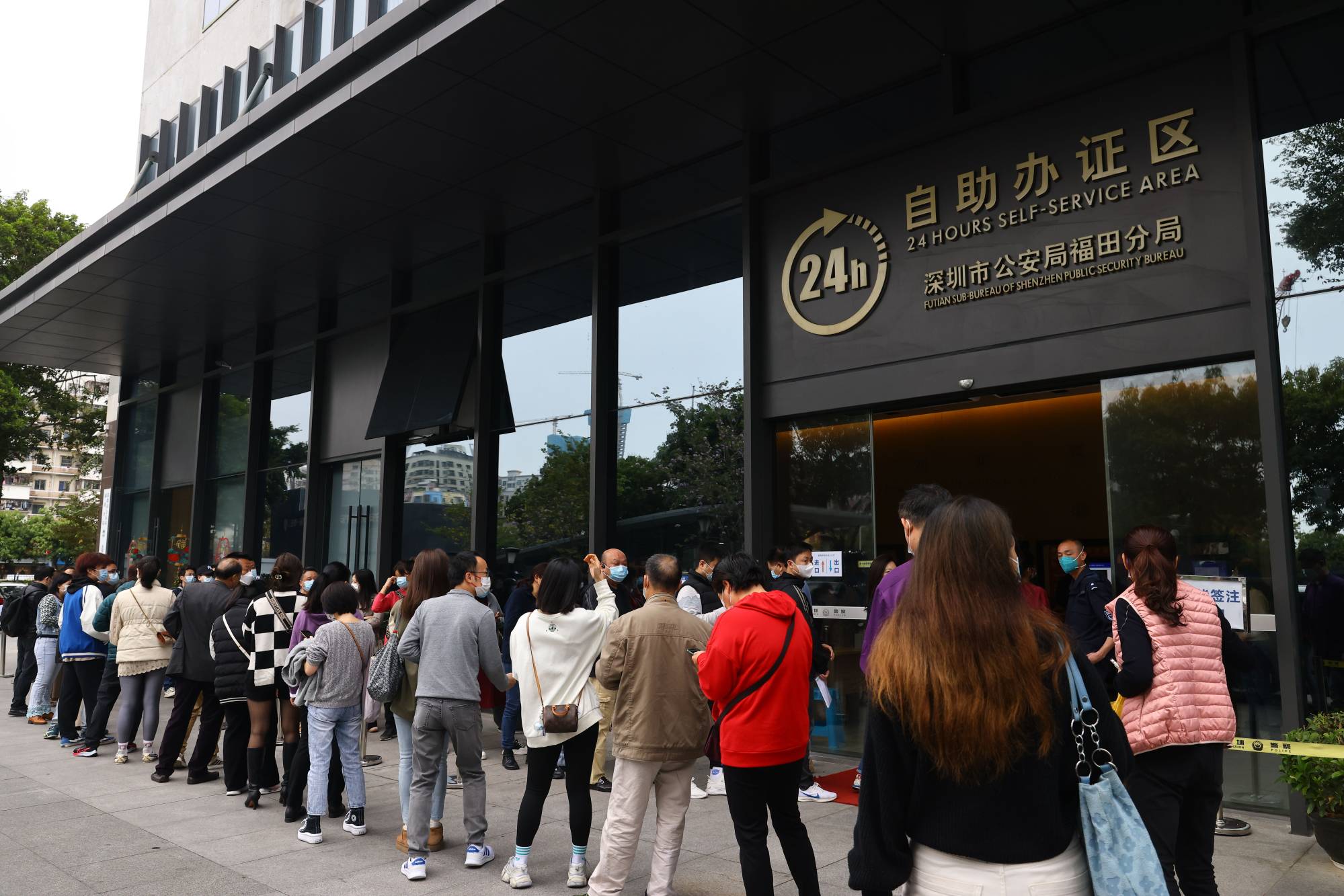
Catering sector: low expectations for business surge
Ray Chui Man-wai, president of the Institute of Dining Art in Hong Kong and who also chairs Kee Catering Group, said he did not expect a significant surge in customers across restaurants and cafes.
“It is just the first day of the border being fully reopened. I don’t expect much for customer flow and business. Post-Lunar New Year holiday is not the peak travelling season as mainlanders need to go back to work,” Chui noted.
He added Hong Kong was still in the initial stage of a return to normality, and people might still need time to adjust and plan itineraries. “I feel confident that more mainland consumers will come during the Easter holiday in April and Labour Day in May.
Smooth bus service on first day
The bus operator for a new shuttle service to and from the Heung Yuen Wai checkpoint reported smooth operations on Monday morning, despite a higher-than-expected number of students and parents.
Louis Kung, Citybus’ Head of Service Delivery (Kowloon & NT), said the first two B7 buses leaving the Heung Yuen Wai checkpoint carried about 200 people, including students and workers.
He said the operator had also seen a larger number of students and parents using the service at the Shenzhen Bay checkpoint, and the frequency of trips was increased to cope with demand.
The Post observed that following an early rush of students, subsequent buses leaving the Heung Yuen Wai checkpoint were noticeably less packed, each of them carrying about two dozen people.
The B7 service, which connects Heung Yuen Wai with the border towns of Sheung Shui and Fanling in Hong Kong, departs every 20 minutes.
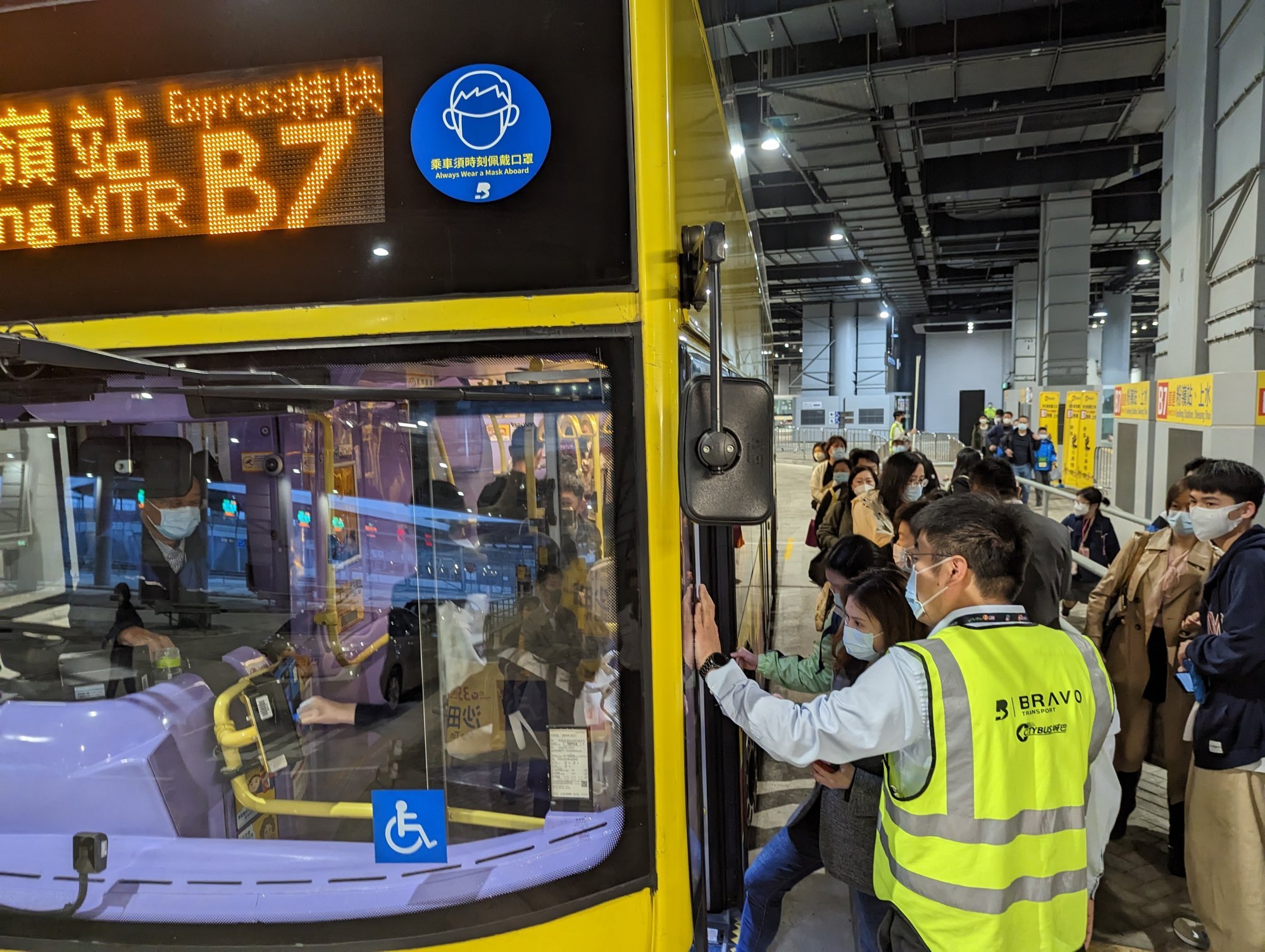
Hundreds queue in Shenzhen to renew visas to Hong Kong
A winding formed at the self-service area of the Shenzhen Public Security Bureau’s Futian branch at around 9am, as mainlanders rushed to renew their visas for Hong Kong and Macau entry.
Monday marked the first day that mainlanders could renew their Hong Kong and Macau entry visas at self-service machines, rather than at manual counters.
By 9.30am, more than 150 mainlanders were queuing for the self-service machines in Futian.
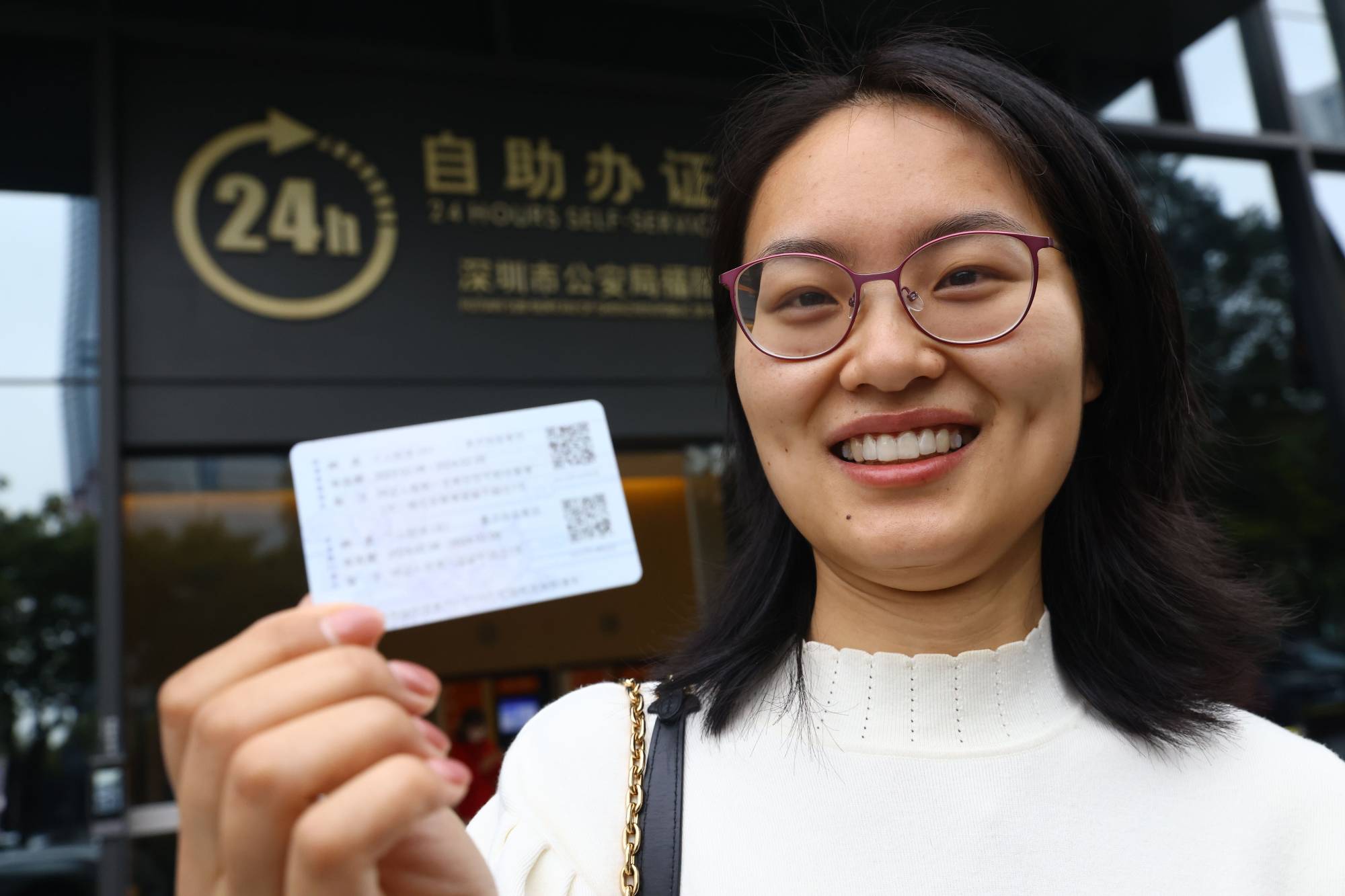
Hannah Wang, 30, was among the early birds who managed to renew their visas before the queue formed. Departing the service centre at 9am, she told the Post that the process was quick and smooth.
“You just need to insert your expired card into the machine, then your picture will be taken and a renewed visa will be produced after you make payment. It only took a few minutes,” she said.
Noting she was very lucky, Wang said she was not aware of the resumption of self-service visa renewals, but was directed to the machines by staff when she arrived at 8.30am.
The PhD student added she would head to Hong Kong immediately through Lok Ma Chau for food and shopping that she had missed over the past three years.
Health declaration help available on mainland side
The Lok Ma Chau checkpoint has quietened down after an initial cross-border dash by students ended past 7am.
As a Post reporter and photographer crossed the border shortly before 8am, passageways on the Hong Kong side of the border were empty.
On the mainland side, there were small crowds of elderly travellers, most of them clustered around five or six help desks along the corridor, where officers helped with health declarations.
Extra manpower at Lo Wu control point
Traffic was light at the Lo Wu checkpoint, as a Post reporter crossed the border to the mainland from Hong Kong at around 8.30am.
The process was smooth in general, with an extra set of gates set up on Lo Wu Bridge for travellers to scan their health declaration codes. Those who had forgotten to fill up their paperwork could do so at a designated area right at the gates.
The Post observed staff being deployed to help such travellers filling out their health declaration forms.
Some travellers were also unfamiliar with immigration procedures and provided wrong travel documents. Extra manpower was assigned to help them.
Guangdong opera excursion
Across the border at Lo Wu, a few tour groups were seen gathering outside the control point, with tour guides flying flags to indicate their locations to clients.
Ng Fung-ying, a 68-year-old retiree and also the chairwoman of a Cantonese opera fan group in Hong Kong, had organised a three-day private tour for 20 to Dongguan to watch a performance.
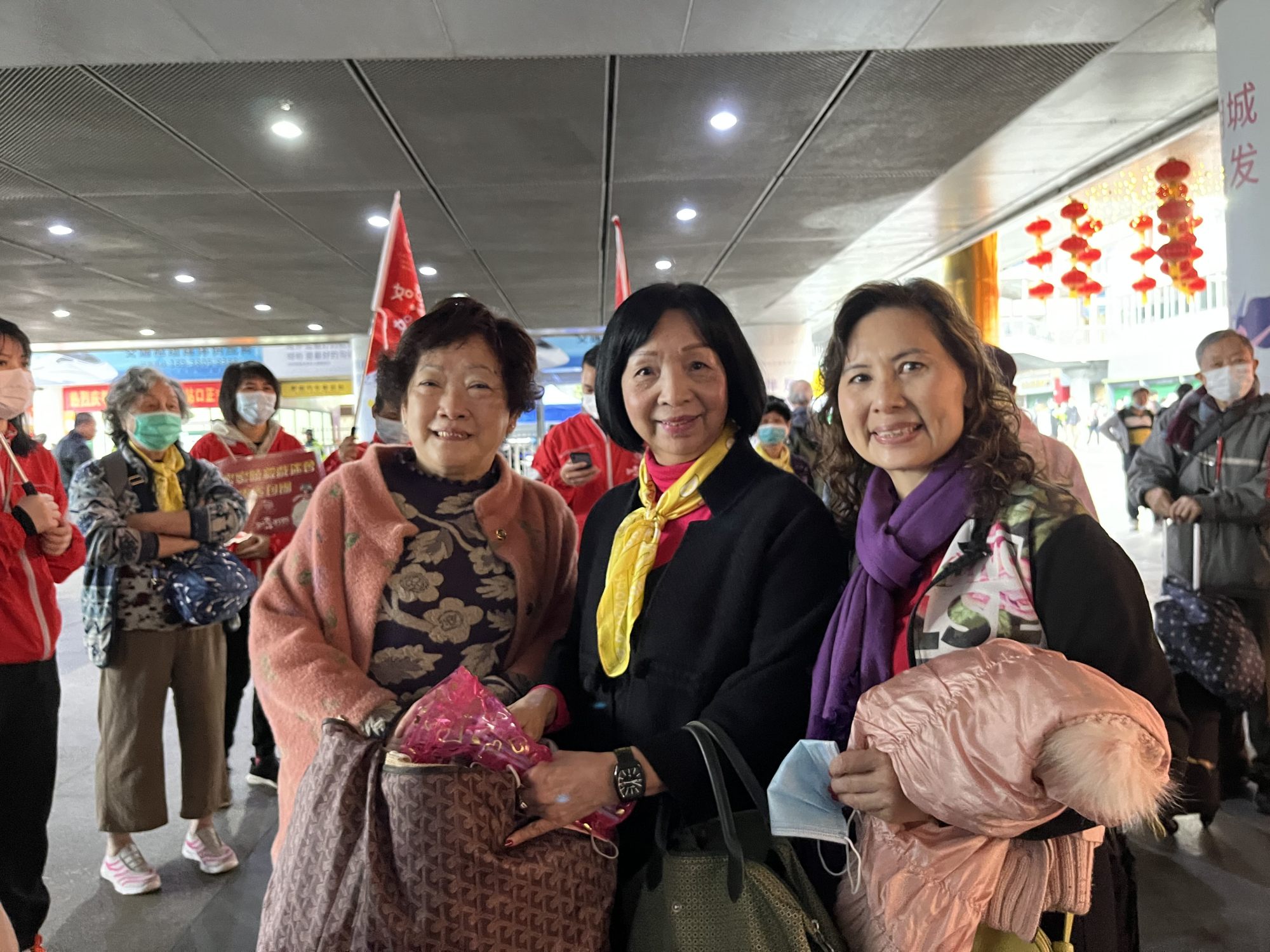
“We can’t wait for the trip! We haven’t watched the show for more than three years!” She said. “We will also travel around and enjoy the luxury hotel on the trip.”
She said each member paid less than HK$2,000 for the trip, calling it a good deal.
“The health declaration requirement did not bother us, because the tour agency helped us deal with it, the whole process was very smooth.”
Cross-border students back before government mandate
As hundreds of students boarded the first few trains from Lok Ma Chau to the city, it seemed some cross-border students had decided not to wait for the official resumption of in-person classes at Hong Kong schools before returning.
The Education Bureau announced earlier this month that cross-border students would be allowed to attend full-day, in-person classes in secondary schools from February 8, while those in the primary level and kindergartens could return on February 22.
Travellers enjoy quieter Heung Yuen Wai crossing
Early travellers arriving at the Heung Yuen Wai checkpoint from the mainland for work hailed the smooth crossing.
Kung Pan-wang, a 30-year-old IT worker who was heading to Tsim Sha Tsui to work, said the thinner crowd made for a smooth experience.
He previously used the Man Kam To checkpoint to commute, which took about two hours. As he lives near the new Liantang border, he voiced hope the new route would save him some time.
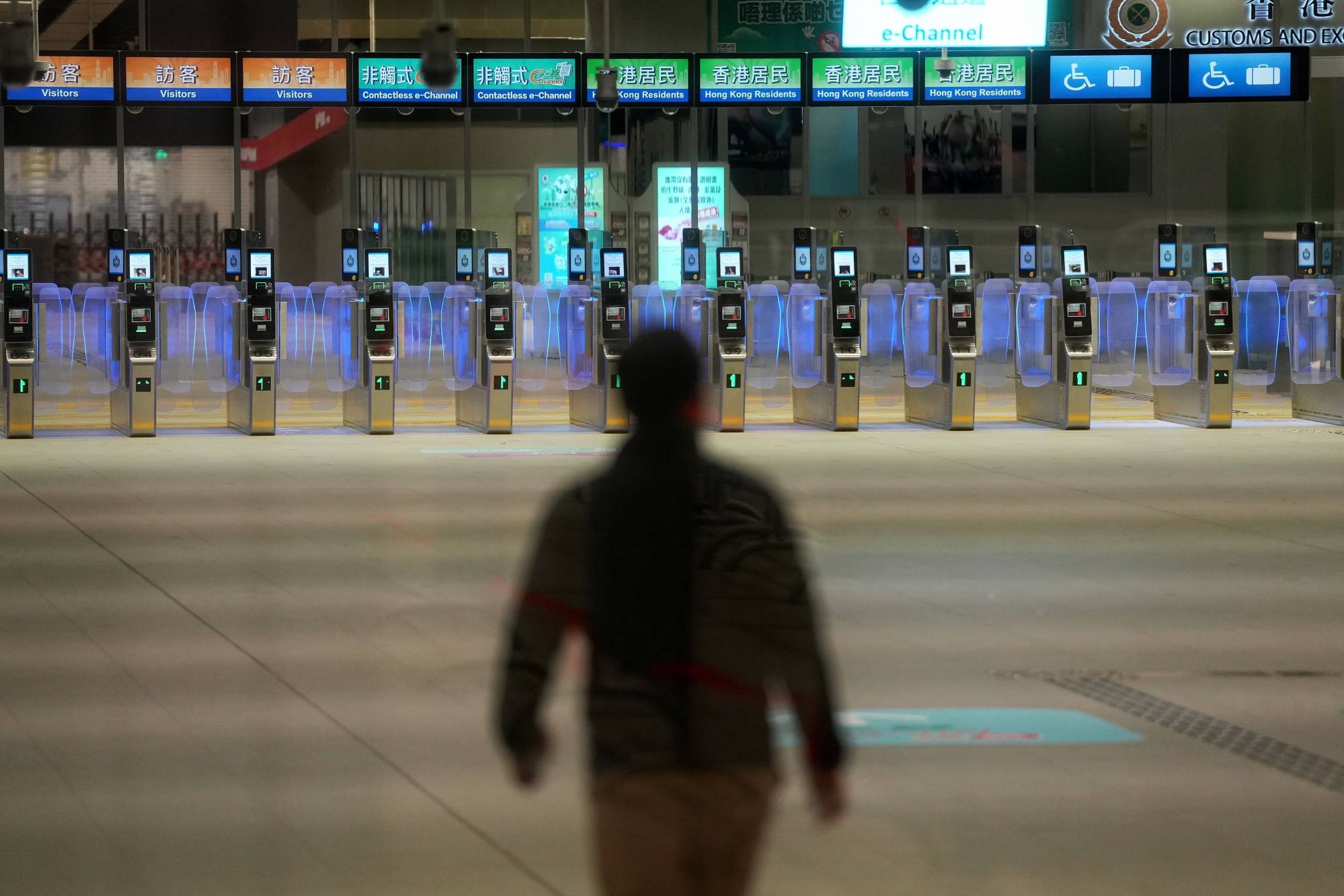
Alan Wong, 63, works for a cosmetic manufacturer and was heading to Hong Kong to meet clients. He said because mainland couriers did not accept liquid items, being able to cross the border in person was important to show his customers product samples.
He added that he enjoyed the relatively empty immigration hall, though the automated gates confused him for a while because there were no other travellers ahead of him.
Another important item on his week-long itinerary was to savour the authentic wonton noodles at a cha chaan teng. It was his first return to his hometown after three years of travel restrictions.
“I’m both nervous and excited. I was born here in Hong Kong and after so many years of not coming back, I’m eager to see what Hong Kong has become.”
Health declaration woes: ‘why WeChat instead of WhatsApp?’
Dozens of Hongkongers were seen making their health declarations outside the Lo Wu control point, with the help of MTR staff.
A 60-year-old man, who only gave his surname as Kong, was among the crowds seeking assistance at the departure hall. Kong said he and his wife, en route to Shenzhen to visit relatives, arrived at around 7am, but spent more than an hour sorting out the paperwork.
“It’s such a mess,” he lamented. “We only learned about this requirement after arriving here.”
“I have no idea why they have to link the webpage with WeChat, we Hongkongers are more used to using WhatsApp.”
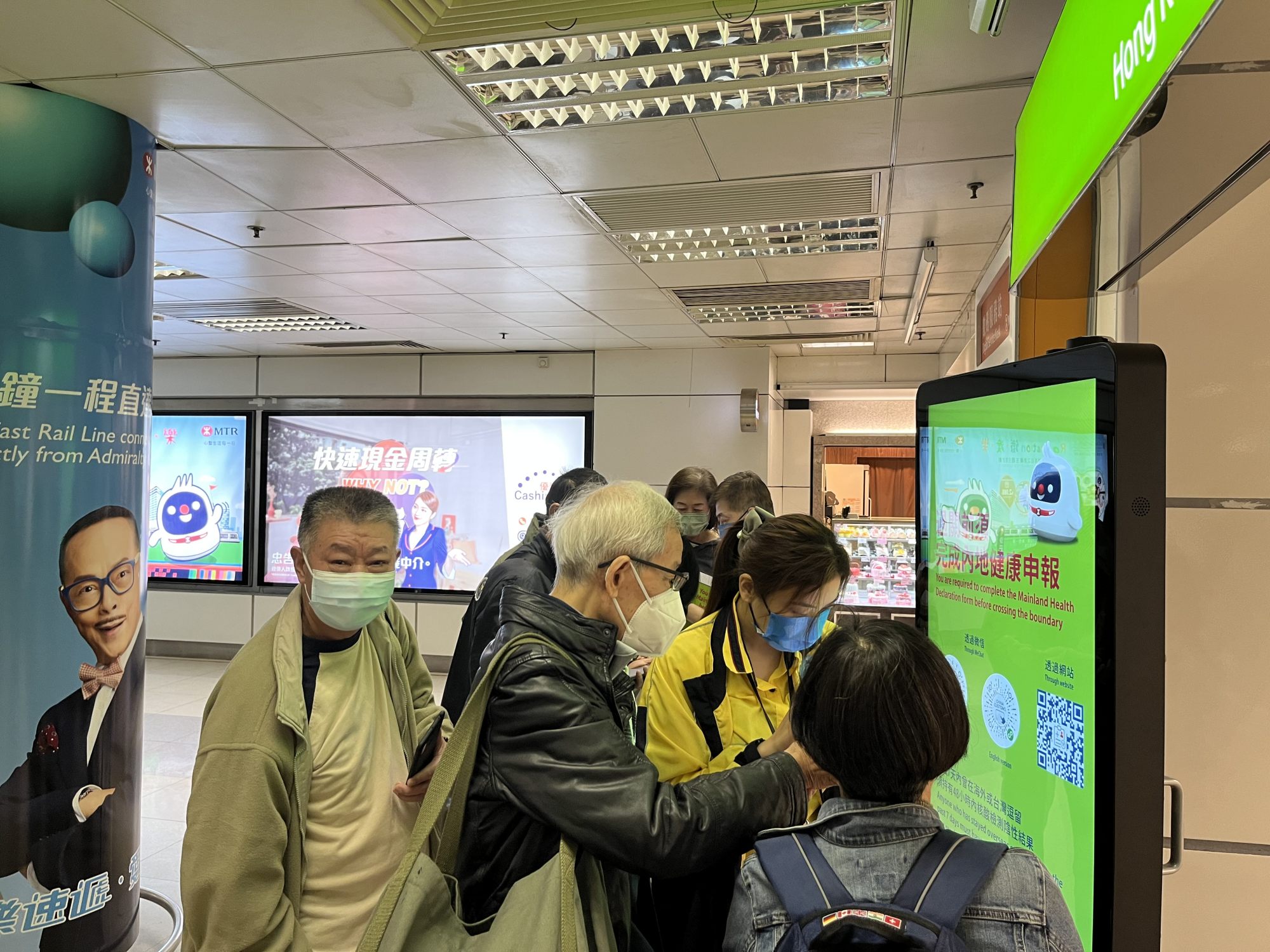
‘Whole process very smooth’
Ivy Li, a 36-year-old business development worker in the United Kingdom, spent a few days in her hometown Shenzhen before crossing the border on Monday to visit relatives in Hong Kong.
“I wanted to visit Hong Kong yesterday via other checkpoints, but I heard the Lo Wu checkpoint would open today, and I live right next to it, so I postponed my trip,” she said.
“The whole process was very smooth, and the checkpoint was not crowded at all. I am carrying huge luggage and had to climb many stairs, but the staff members were very helpful.”
‘Witnessing history’ as Heung Yuen Wai crossing opens
The Heung Yuen Wai border facility opened punctually at 7am, welcoming its first travellers since operations began in August 2020.
Outnumbered by the press, about a handful of people entered the gate and made their way to Shenzhen.
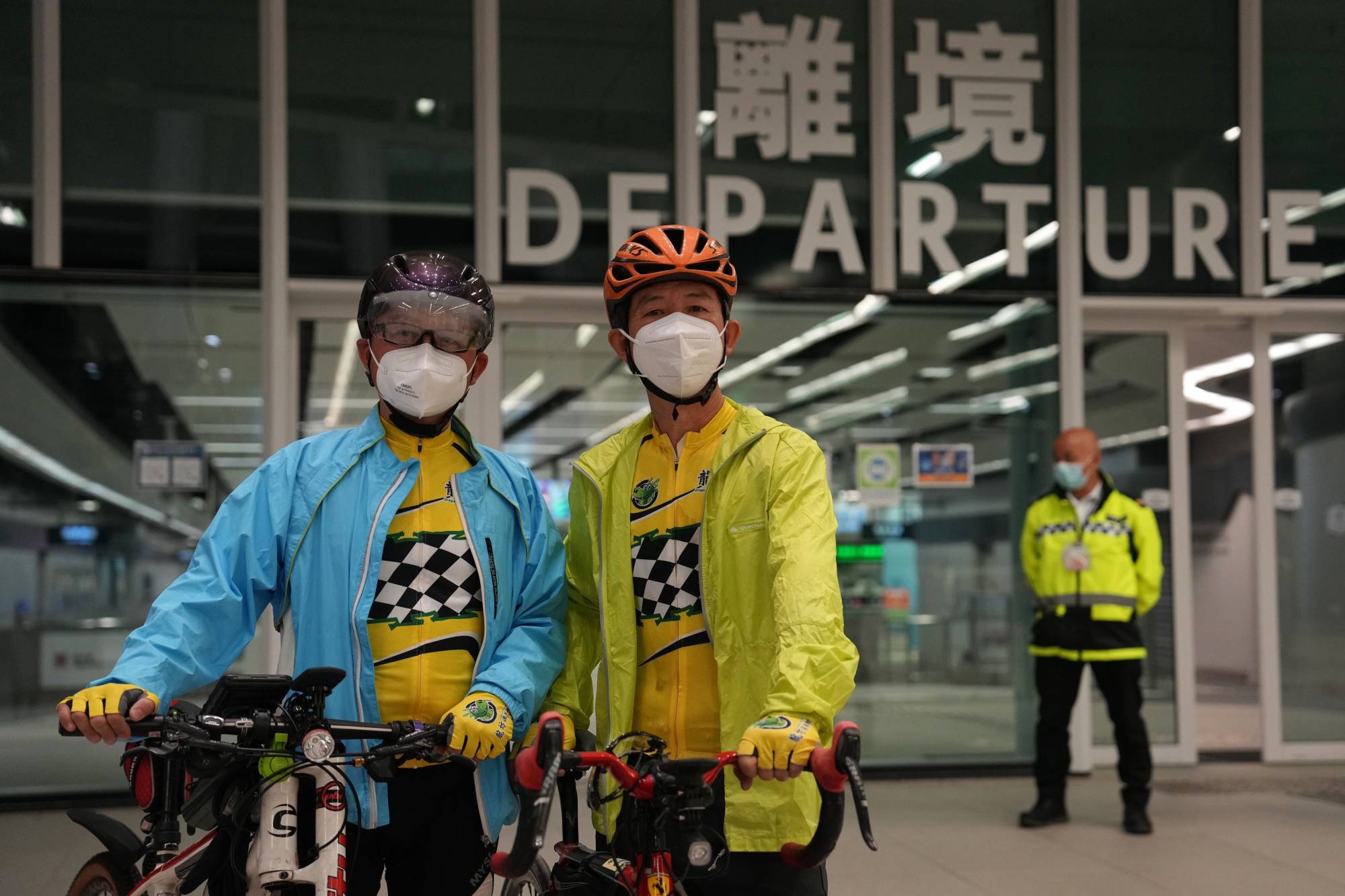
Veteran cyclist Man Hok-him, 57, was the first person waiting at the checkpoint. A San Tin resident, he used to ride his bike on the mainland many times a week before the border closed.
“It is witnessing history,” he said with excitement. “There might not be another new border checkpoint opening that I can be part of.”
Tourists glad to be back in Hong Kong but more discounts, better service wanted
There were more arrivals than people leaving Hong Kong, many of the former being cross-border students.
Jeffrey Lok, 15, said the Heung Yuen Wai checkpoint was closer to his Shenzhen home and he might be able to save about half an hour in his daily commute to his school in Tai Po.
For 13-year-old Anson Ngai, it was his first time seeing his classmates at a Fanling secondary school after a three-year absence from in-person lessons.
“I’m so excited to meet my classmates for the first time,” he said.
The 7am opening time was apparently tricky for students, as most schools started at 8am. Many dashed to take the first bus leaving the checkpoint.
The bus operator deployed an employee to help activate overdue Octopus cards for the mainland arrivals. Passengers were also reminded they could use mobile payments on the bus.
Hong Kong visit ‘now much easier’
Wen Weichang, 50, a traveller from Dongguan city in Guangdong province, caught the first train to Lo Wu with his mother, after spending two days in Hong Kong.
“We are much more familiar with Lo Wu station, we had been using this control point for years,” he said. “It’s much more convenient that the PCR test is dropped, we don’t have to arrange a time for it a few days in advance.”
Comparing his visit to the city to pre-Covid times, he said he found the streets less crowded this time, and people were more distant due to the mask mandate.
He said he expected to visit Hong Kong more, following the full resumption of cross-border travel.
Long school journey worth it for reunion with parents, student says
Student Hugo Wu, 14, took the second train from Lok Ma Chau shortly before 7am to head to school in Fanling.
The Form Three student said his long trip to school, which began at 5.30am, was no hassle as he could see his parents every day.
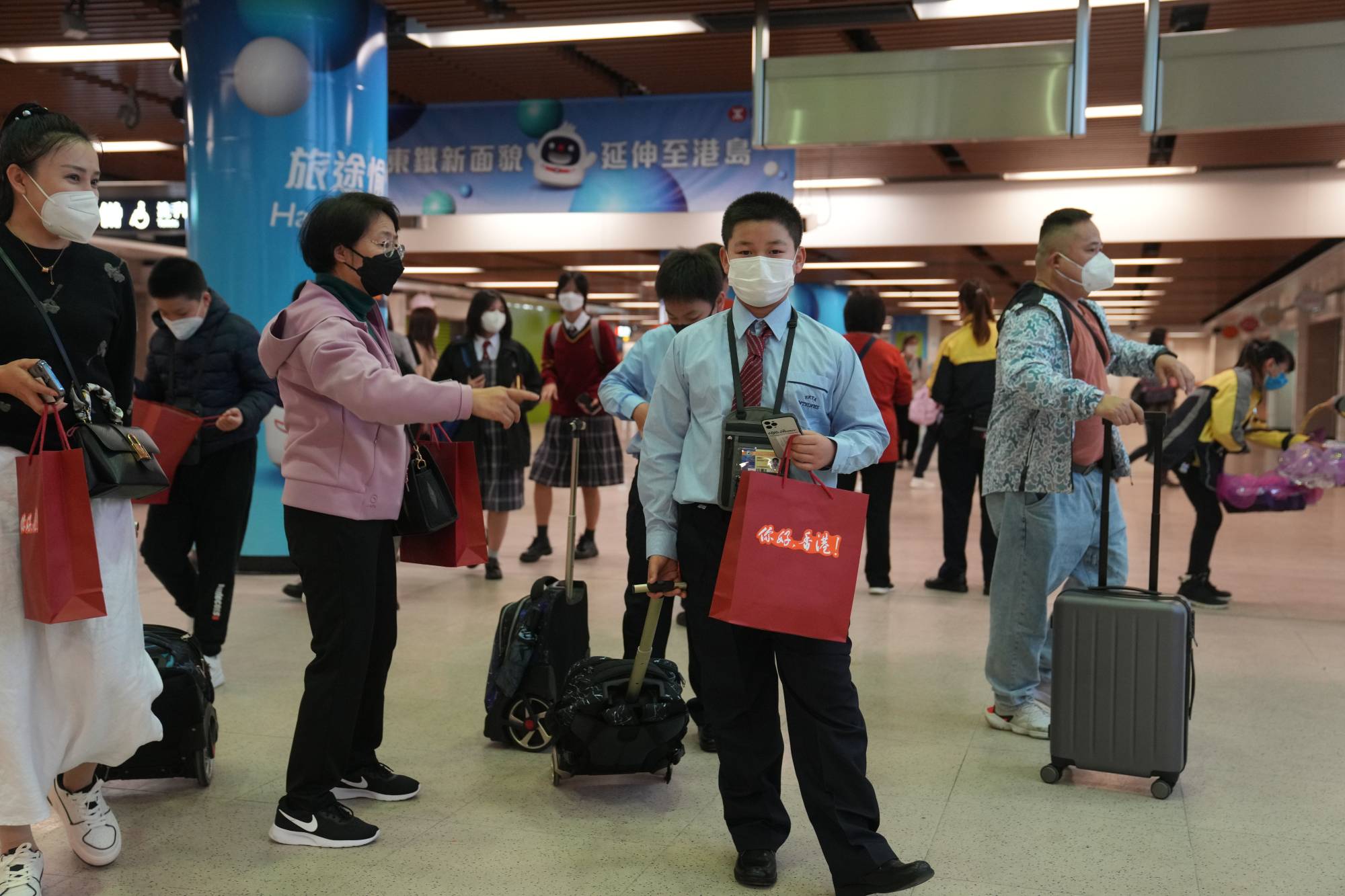
“Before this, I lived away from my parents in Hong Kong. I get to see them more now,” Wu said.
The cross-border student had stayed with a relative in Kowloon since last August and only returned to his home near Futian last week, after quarantine-free travel resumed.
Wu added that his journey on Monday had been smooth as he felt less stressed about travelling as the testing and reservation requirements had been lifted.
Health declaration a hassle for retiree
Wong Pui-yuen, a retiree in his sixties living on the mainland, was among the first batch of passengers waiting for the Lo Wu checkpoint to open, after spending Lunar New Year in Hong Kong.
“I came to Hong Kong via the Lok Ma Chau checkpoint, but I heard the Lo Wu border has reopened, so I came to check it out,” he said.
Wong expressed frustration at having to fill out a health declaration form.
“The health declaration requirement is so troublesome, I don’t know how to do it,” he said, “The last time I had to fill it out at the checkpoint, it took me more than 10 minutes.”
Cross-border students rush to school from Lo Wu station
At the arrival hall of Lo Wu station, hundreds from the mainland, mostly cross-border students, rushed to the exit gates to catch the first train to the city.
Kevin Zhang, a sixth-grader, has been attending online classes for the past three years and made his return to campus on Monday.
“I wish to attend the physical education lessons the most, so we don’t have to sit in the classroom,” he said. “I also miss my teachers and classmates.”
His mother said she heaved a sigh of relief, knowing border restrictions would be eased on Monday, adding that taking PCR tests and making reservations online in advance were too much trouble.
Staff from the MTR Corporation and Hong Kong Tourism Board were distributing souvenirs, including masks, and spending vouchers.
The Education Bureau had said cross-border students would return on February 8, though New Territories School Heads Association vice-chairman Chu Wai-lam noted that senior students could come back on their own regardless of the government’s plan.
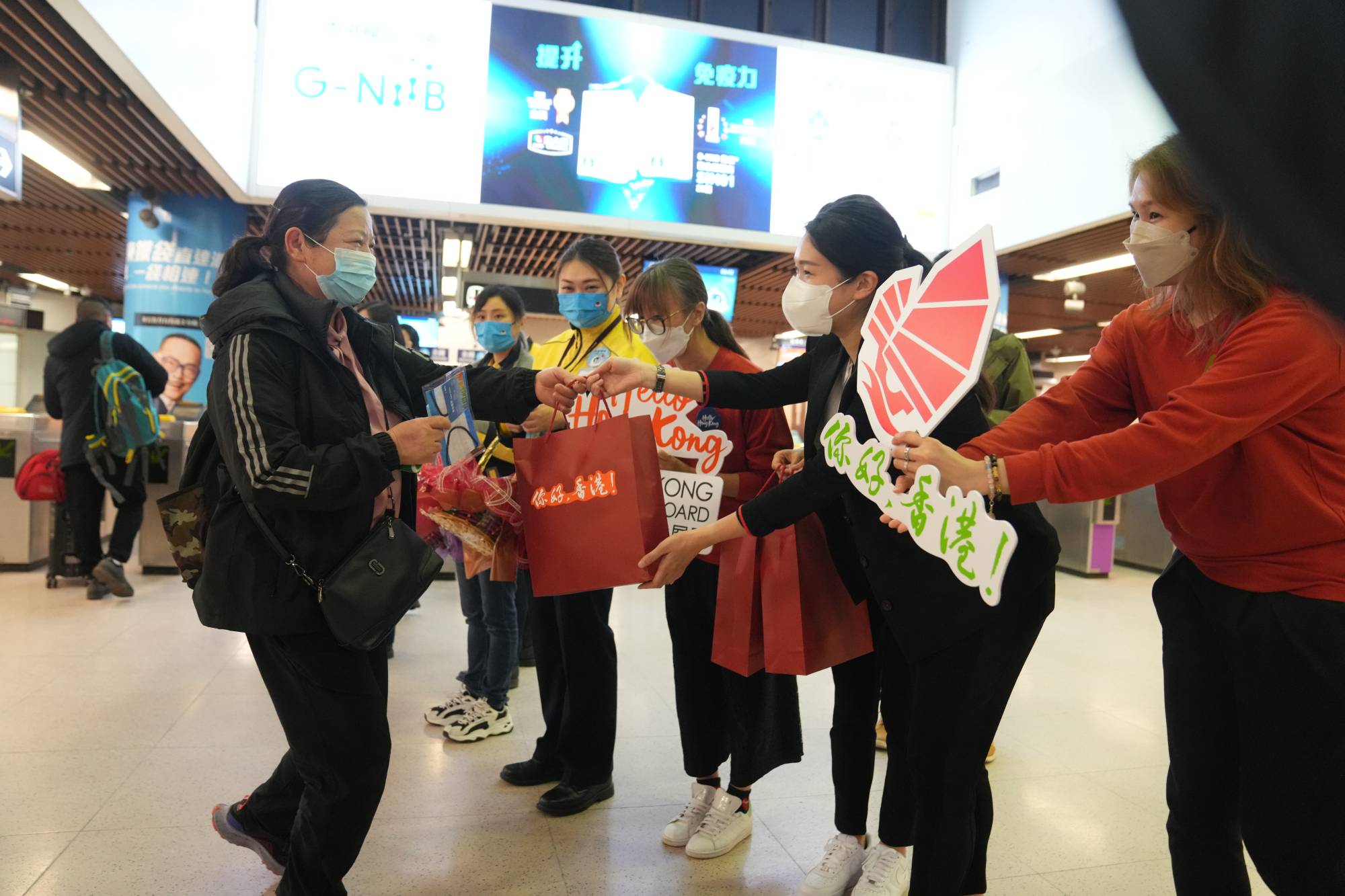
Merchandiser back in business
At around 6.30am, more than 150 passengers queued at the departure hall of Lo Wu control point, waiting for the gates to open for the first time in three years.
Selina Li, 60, merchandising director at a Lo Wu duty-free shop, caught the first train to the station.
“When the border was closed, we had to open some pop-up stores in the city to save the business,” she said. “So the reopening of the border is great news to us, we can finally return to business.”
Students head to school from Lok Ma Chau
While Lok Ma Chau opened to a slow start with only 10 passengers on its first train to the city, the terminus quickly filled up with more than 100 students.
By 7am, the train departing for Admiralty was filled with students of all ages with more dashing from the platform to get on board.
Homemaker Mrs Chan, 48, said she woke up at 5.40am to take her 11-year-old son to Fung Kai No 1 Primary School in Sheung Shui.

“It is earlier than usual as I needed spare time for our Octopus cards to be activated. I’m treating this as training to toughen up my kid,” Chan said.
She said their Octopus cards had expired and required activation at the station counter because the pair had not been to the city since the pandemic began three years ago.
Chan said she was looking forward to the resumption of cross-border school bus services on February 22, which would reduce her son’s commute time by almost two hours.
Quiet start at Lok Ma Chau station
In stark contrast to the hustle and bustle of the Lo Wu-bound crowd, the first train to Lok Ma Chau departed from Sheung Shui station at 6am with few seats filled.
While around 40 passengers took the first train to Lok Ma Chau from Sheung Shui, most were revealed to be staff of the terminus as only nine people stopped at the border control point after alighting.
Opening at 6.30am, the Lok Ma Chau border checkpoint connects travellers with the Futian port in Shenzhen.
A passenger who gave his surname as Mao said he took the first train to send his son to school in Xixiang, Shenzhen.
The logistics worker, 40, said his son had been taking online classes for the past two years due to the pandemic, but would relocate to Shenzhen from Monday.
“Travelling won’t be tough as long as there are no restrictions,” Mao said, noting that he waited until Monday to make the trip as he found the previous testing and reservation requirements a hassle.
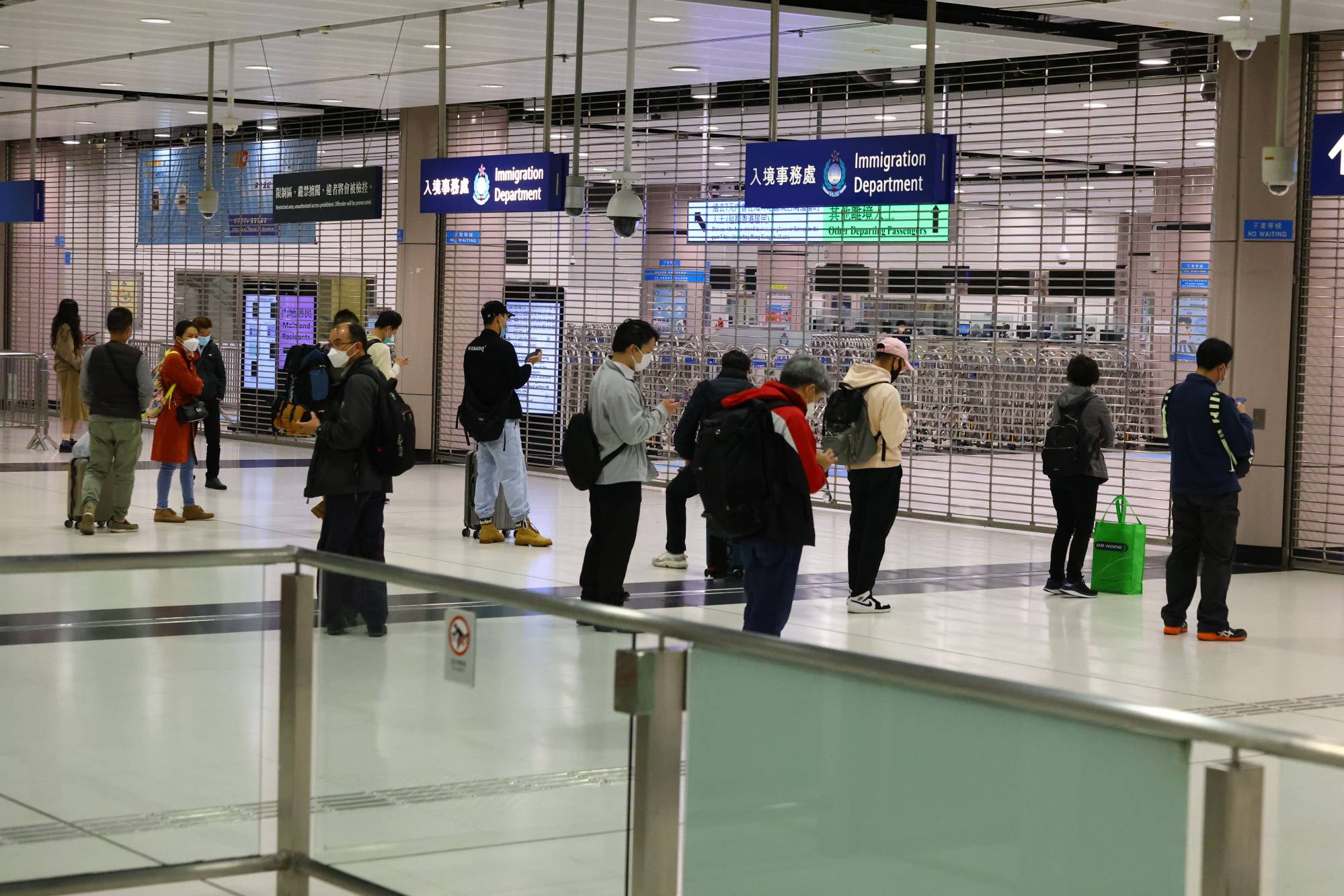
Early birds board first bus to Heung Yuen Wai
Outside Fanling MTR station, a handful of travellers were waiting for the first bus to the Heung Yuen Wai checkpoint before dawn.
Retiree Robert Mak, 67, was going to meet his friends at the Shenzhen North station for a Lunar New Year greeting.
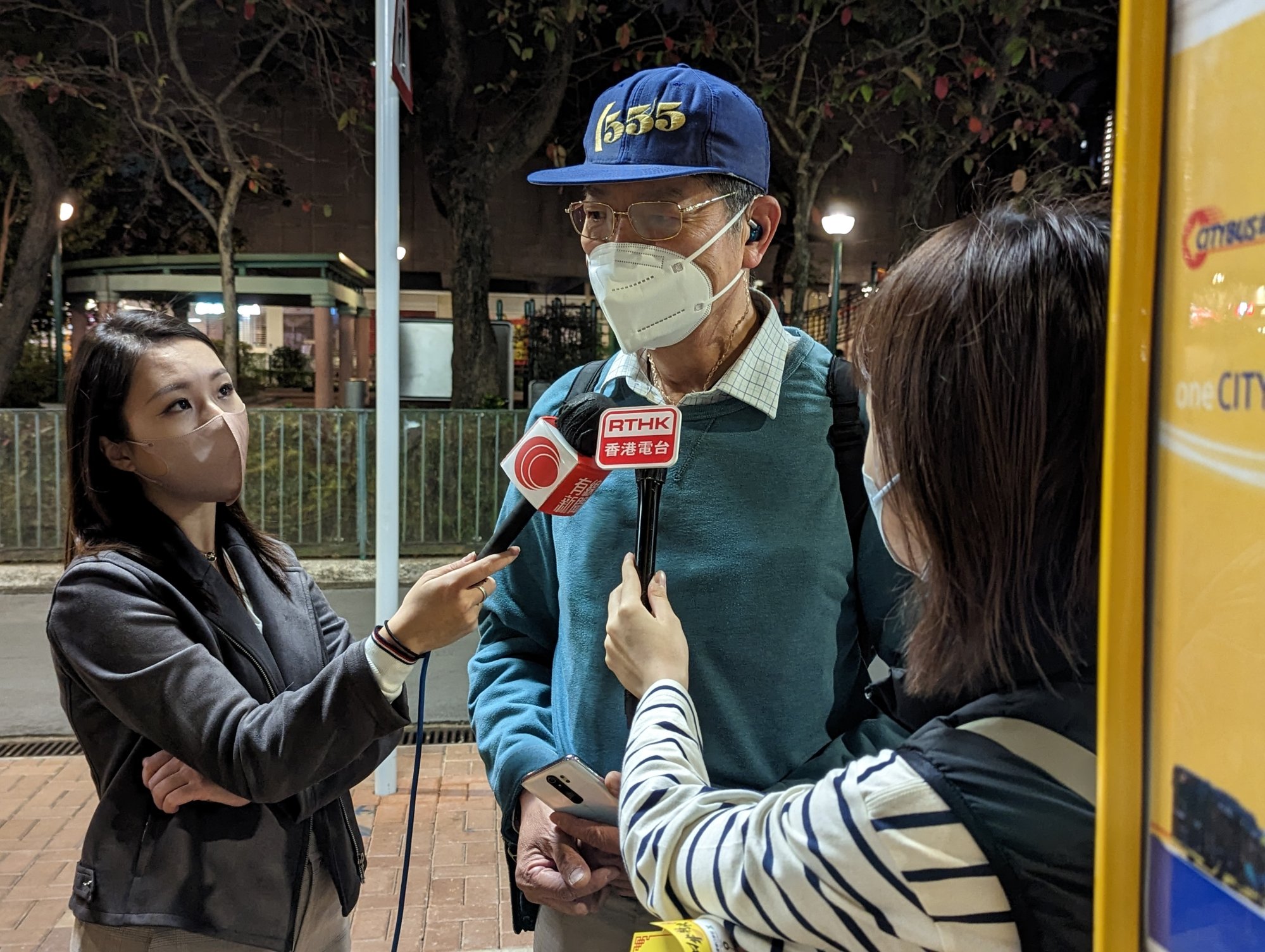
“Rather than greetings by phone or video call, why not meet in person?” he said.
Mak, who lives in Fo Tan district, said he wanted to avoid the midday crowds. This was also his first trip to the mainland since travel restrictions were eased on January 8.

But he said his first return to the mainland in three years was “not exciting at all” because this had been his regular commuting pattern since the 1980s.
The first bus also saw a handful of enthusiasts on board filming the entire ride from the front row on the upper deck.
It took the group about 20 minutes to reach Heung Yuen Wai.
Operating hours of the newly added control points
Lo Wu and Lok Ma Chau land crossings reopen on Monday, with the latter bringing back round-the-clock travel between Hong Kong and Shenzhen after midnight.
The new checkpoint in Heung Yuen Wai, which has been used by trucks only since 2020, will open for passenger traffic for the first time from 7am to 10pm. The Sha Tau Kok crossing will open from 7am to 10pm but will be limited to cargo transport.
The checkpoints reopened earlier included three land borders at the Lok Ma Chau Spur Line, Shenzhen Bay and Man Kam To.
Transport Department reminders
The Transport Department on Sunday appealed to residents who were planning to travel to and from the mainland to learn about services available and details of the checkpoints in advance, including the first-run vehicle and its frequency.
Border reopening good for Hong Kong’s economy: Paul Chan
Financial Secretary Paul Chan Mo-po said the full resumption of quarantine-free travel between Hong Kong and the mainland on Monday was expected to help the post-pandemic recovery of a variety of businesses and the tourism sector and that cross-border passenger and cargo traffic would increase steadily.
“It will also bring a more positive and optimistic outlook for the overall economy of Hong Kong,” he said on his blog.
But Chan warned the city should remain cautious about the economy and highlighted a 28.9 per cent drop in the value of Hong Kong’s exports last December.



